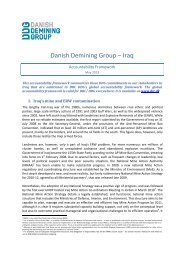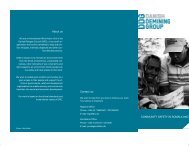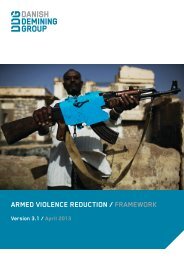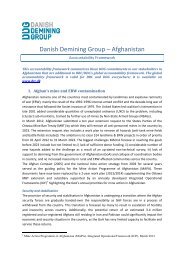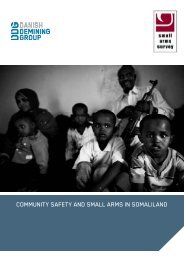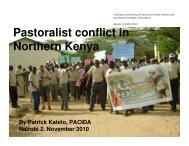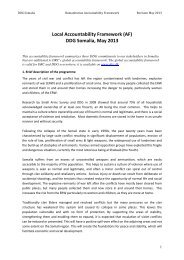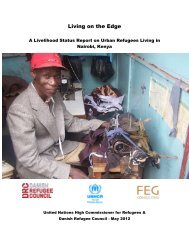Read the full report - Danish Refugee Council
Read the full report - Danish Refugee Council
Read the full report - Danish Refugee Council
You also want an ePaper? Increase the reach of your titles
YUMPU automatically turns print PDFs into web optimized ePapers that Google loves.
42 DRC / DANISH REFUGEE COUNCILSECTION III: Implementing cash-based programmes in <strong>the</strong>KIS?The choice of a form of implementation depends on <strong>the</strong> objectives of <strong>the</strong> programme. This iscommon to all types of programme – whe<strong>the</strong>r cash or in-kind – and ensures <strong>the</strong> intervention is anincentive compatible with <strong>the</strong> intended outcomes of <strong>the</strong> programme.As underlined by previous studies and confirmed by findings from <strong>the</strong> present research, with 81% ofrespondents corresponding to EVI criteria, <strong>the</strong> situation of IDPs living in KIS is one of general povertyand high vulnerability. Realistic objectives will <strong>the</strong>refore need to be framed accordingly: high levels ofvulnerability, multiple discrimination and lack of recognition of <strong>the</strong>ir right to settle prevent KISinhabitants from escaping spirals of poverty and indebtedness. All <strong>the</strong>se factors of vulnerability areinterrelated and impact on <strong>the</strong> general livelihood situation of poor households living in <strong>the</strong> KIS. Hence<strong>the</strong> need for simple and clear objectives, tailored to <strong>the</strong> needs identified.Given objectives are clear and <strong>the</strong> programme is planned accordingly, <strong>the</strong> potential advantage ofcash-based approaches is <strong>the</strong>y potentially allow linking relief and recovery by alleviating short-termpoverty through allowing people to address <strong>the</strong>ir direct needs, while incentivizing families to invest inlonger-term activities and human capital impacting on <strong>the</strong>ir livelihoods. As outlined in <strong>the</strong> table above,this can be considered through a combination of forms of assistance, with in-kind providing forimmediate basic needs (food and fuel), and cash grants allowing households to address o<strong>the</strong>r urgentneeds (repayment of debts, health) or invest <strong>the</strong>ir resources in a longer-term perspective (humancapital).In DRC’s perspective of promoting livelihoods in KIS, a range of objectives can be considered topermit households to break <strong>the</strong> cycle of indebtedness, and eventually attain higher living standardsand secure livelihoods:Table 6: Cash transfer, a relief and recovery instrument?ObjectiveReliefIncreasing food consumptionImproving access to heatingcommoditiesPreventing distress coping mechanismsdamaging health and livelihoodsRecoveryUpgrading skillsBehavioural changes: higher investmentin human capital.Facilitating investment in productiveactivitiesCash modalityCombination of cash grants and in-kind.Vouchers.Combination of cash grants and in-kind.Cash for trainingConditional cash transfers for preventivehealth visits or school attendance.Cash for trainingConditional cash transfers forcommodities.“Cash is a means for an end; we first have to know what <strong>the</strong> money is intended for. If <strong>the</strong> objectivesare well defined, <strong>the</strong>n cash can be very useful” – Cash Learning Coordinator – NRC“There’s an element of impacting on traditional coping mechanisms. There are things <strong>the</strong>y could doanyway as a community initiative. If organizations come and pay for this, <strong>the</strong>y wait for organizationsto come, and we need to avoid that” – ACF



